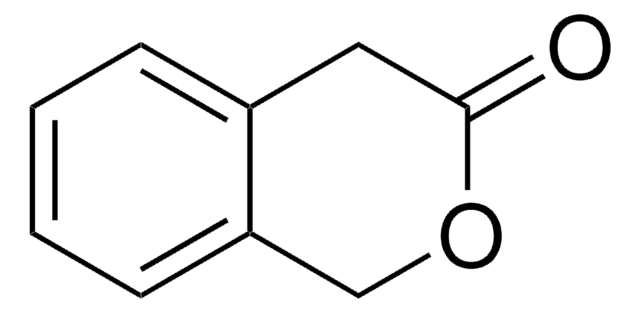W238104
Dihydrocoumarin
≥99%, FCC, FG
Synonyme(s) :
3,4-Dihydro-1-benzopyran-2-one, Benzodihydropyrone, Hydrocoumarin
About This Item
Produits recommandés
Source biologique
synthetic
Niveau de qualité
Qualité
FG
Halal
Kosher
Agence
meets purity specifications of JECFA
Conformité réglementaire
EU Regulation 1334/2008 & 178/2002
FCC
FDA 21 CFR 117
Pureté
≥99%
Indice de réfraction
n20/D 1.556 (lit.)
Point d'ébullition
272 °C (lit.)
Pf
24-25 °C (lit.)
Densité
1.169 g/mL at 25 °C (lit.)
Application(s)
flavors and fragrances
Documentation
see Safety & Documentation for available documents
Allergène alimentaire
no known allergens
Propriétés organoleptiques
coconut; coumarin; sweet
Chaîne SMILES
O=C1CCc2ccccc2O1
InChI
1S/C9H8O2/c10-9-6-5-7-3-1-2-4-8(7)11-9/h1-4H,5-6H2
Clé InChI
VMUXSMXIQBNMGZ-UHFFFAOYSA-N
Vous recherchez des produits similaires ? Visite Guide de comparaison des produits
Catégories apparentées
Description générale
Application
- Novel Dihydrocoumarins Induced by Radiolysis as Potent Tyrosinase Inhibitors.: This research identifies new dihydrocoumarins produced through radiolysis, demonstrating their potential as effective tyrosinase inhibitors, which could have significant applications in dermatology and related fields (Jeong et al., 2024). (Jeong et al., 2024).
Actions biochimiques/physiologiques
Autres remarques
Mention d'avertissement
Warning
Mentions de danger
Conseils de prudence
Classification des risques
Acute Tox. 4 Oral - Skin Sens. 1
Code de la classe de stockage
10 - Combustible liquids
Classe de danger pour l'eau (WGK)
WGK 1
Point d'éclair (°F)
>212.0 °F - closed cup
Point d'éclair (°C)
> 100 °C - closed cup
Équipement de protection individuelle
Eyeshields, Faceshields, Gloves, type ABEK (EN14387) respirator filter
Certificats d'analyse (COA)
Recherchez un Certificats d'analyse (COA) en saisissant le numéro de lot du produit. Les numéros de lot figurent sur l'étiquette du produit après les mots "Lot" ou "Batch".
Déjà en possession de ce produit ?
Retrouvez la documentation relative aux produits que vous avez récemment achetés dans la Bibliothèque de documents.
Les clients ont également consulté
Notre équipe de scientifiques dispose d'une expérience dans tous les secteurs de la recherche, notamment en sciences de la vie, science des matériaux, synthèse chimique, chromatographie, analyse et dans de nombreux autres domaines..
Contacter notre Service technique
















